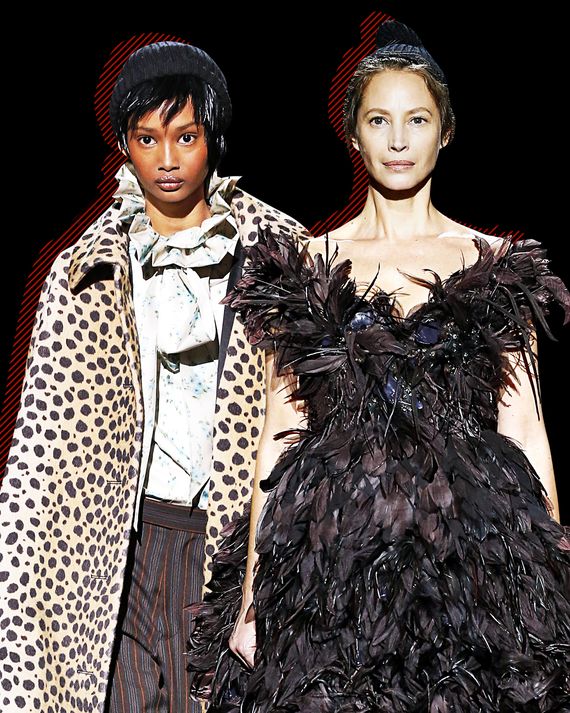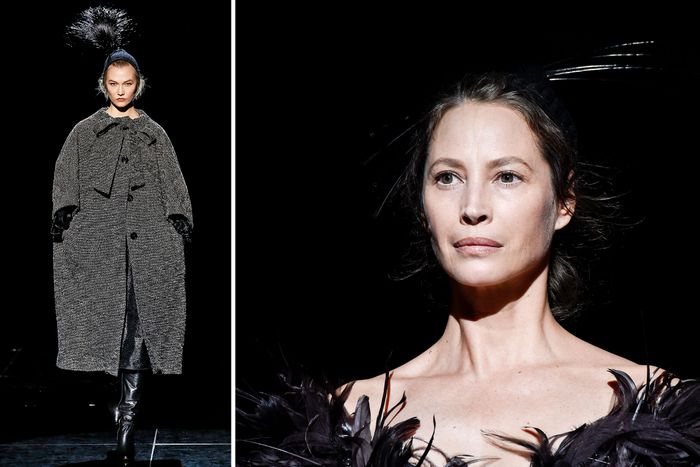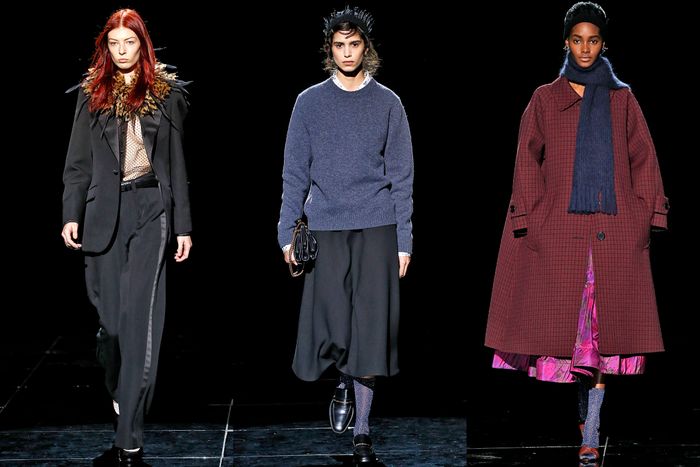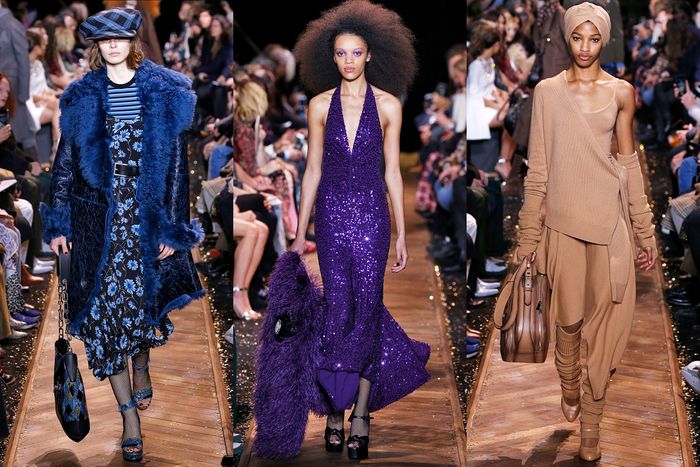
The Park Avenue Armory was nearly pitch-black as guests arrived for Marc Jacobs’s show, as always the last of the New York fall collections. This time, 180 seats were arranged in a tight block in the center of the hall; at 6 p.m. sharp the lights went completely down and a spotlight rose on a string group, the American Contemporary Music Ensemble. It would play only one piece of music for the length of the show, Bryce Dessner’s “Aheym.” In Yiddish, Aheym means homeward.
Given that his last two shows directly referenced European couture legends, it wasn’t surprising that Jacobs chose to bring his collection “home” again. Christy Turlington, who modeled in his famous ’90s grunge collection, closed the show; Turlington hasn’t been on a runway in perhaps 20 years. Many of the wool capes and slightly barrel-shaped coats seemed a nod to the coat-and-suit tradition of Seventh Avenue, especially Pauline Trigère. And the models’ adorable knit beanies, by the milliner Stephen Jones, with a feather or two stuck in the crown, seemed a link to Jacobs’s own “downtown” style.
But it wasn’t as simple as that, just as “home” itself rarely is.
What impressed me most about this remarkable show was how Jacobs highlighted the individuality of every outfit, every choice of fabric and color, every small detail — from the model Ugbad Abdi in the opening look of an animal-spotted cape over a frilled-neck silk print blouse and brown striped trousers through to Turlington’s majestic, off-the-shoulder black dress covered in feathers — in order to masterfully present his version of a modern wardrobe.
The show was so deliberate in its ordering and styling, with each model appearing in a spotlight and then disappearing into the darkness of the Armory — and no look repeated — that I sometimes felt that Jacobs was attempting to perform an exorcism on his audience. Forget all the shenanigans you’ve seen this past week attempting to pass for fashion. I’m going to show you the real thing.
There was the statuesque Karlie Kloss in a charcoal tweed coat, the color of Manhattan in mid-winter, with a tie at the neck, black boots, and a black plume spraying from her cap. (Jones said there were about 15 varieties of feathers in all, from duck to stripped peacock quills.) Jacobs used menswear checks liberally — Prince of Wales, windowpane — but no two results were the same. A coat in deep magenta glen plaid was followed by a pantsuit in a light-gray check with a glossy finish and a sheer pale-blue blouse with a pussy bow.
And I loved how Jacobs dropped a plain, nerdish crewneck sweater and skirt into the lineup — just one — and, also, a very elegant tuxedo with a sheer black dotted blouse before raising the tempo again with a striking coat in mint green and then an extravagant, off-the-shoulder tiered gown in bitter lemon silk.
The show’s emotional grip had a lot to do with the way Jacobs deployed his colors amid the mid-winter slates and browns, and also with the austere beauty of the models, who wore little makeup (the superb work of Diane Kendal) and had wisps of hair (from Guido Palau) escaping from their caps. Jones said backstage that when he and Jacobs discussed what type of hat to do, the directive was “modern” — and a beanie, they decided, was the most modern of all.
Modern doesn’t mean a minimalist pantsuit or a novel way to dye jeans, though those things can look new and interesting. For me, modern in fashion is much more of a elusive mood — a mixture of great ease with historical modes, a grown-up sensibility, a real regard for feminine characters, and the ability to express all those qualities with authority.
Jacobs’s authority was on display last night. And it helped that he pulled threads from his last two over-the-top collections (the frilled-neck shirts, the sack dresses) into this one, as if to give us a different context for appreciating those styles.
Michael Kors provided the bookend for a strong finish to NYFW. Disco at 10:30 a.m.? Why not, if you’re an intrepid traveler to the glamour spots. Though disco balls and prints of the Studio 54 logo — not to mention a live performance by Barry Manilow — pointed to the club scene of the ’70s, Kors took a broader view of the decade’s influences, notably from the ballet and modern-dance worlds. There were sexy layers of knits, slinky dresses in sequins, and shag-trimmed brocade coats (or braided military coats) that brought to mind the off-duty style of Russian dancers. Overall, with so many frilled crepe dresses or skirts and great coats, the collection was a huge boost over Kors’s tepid spring line.






